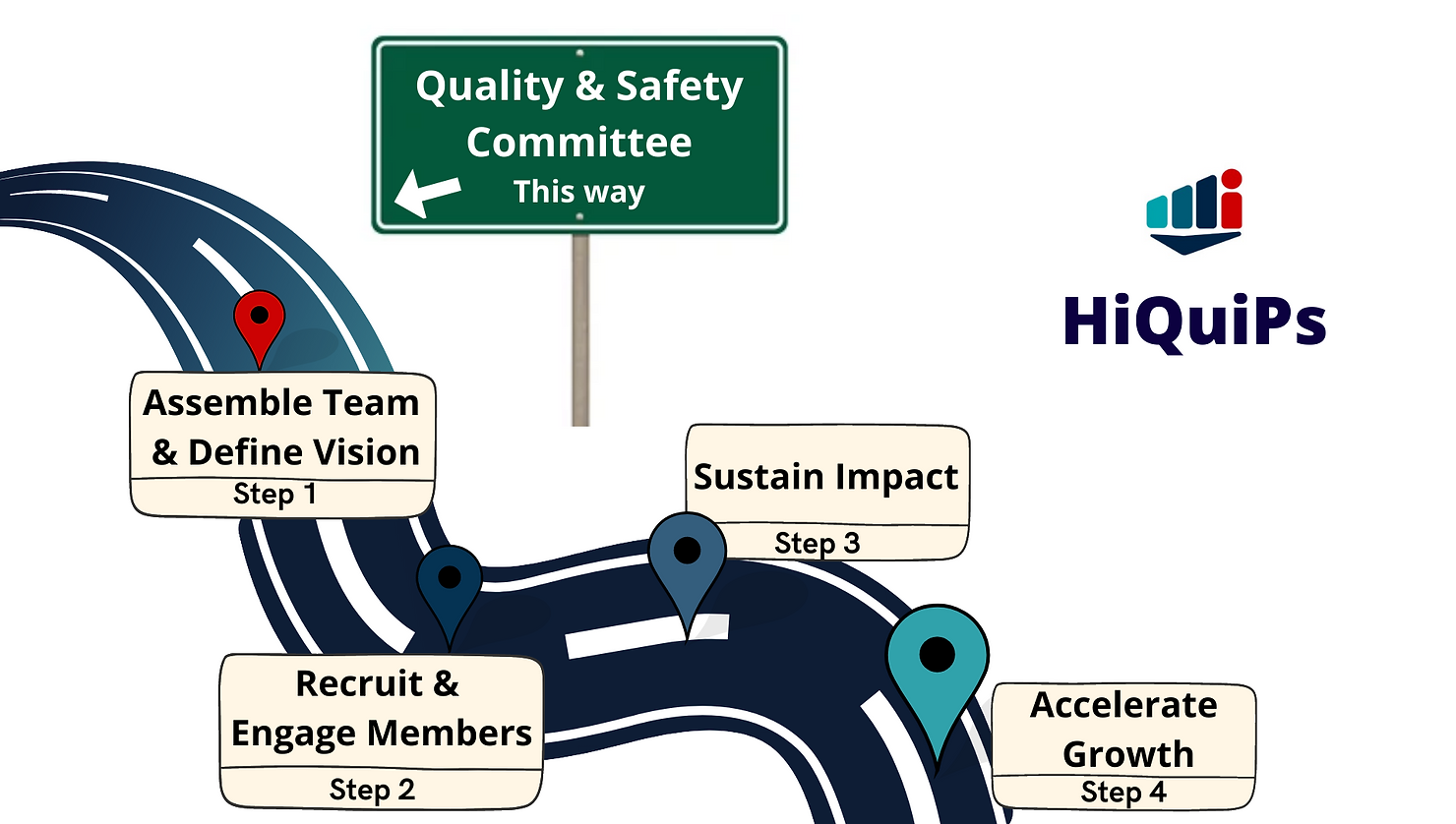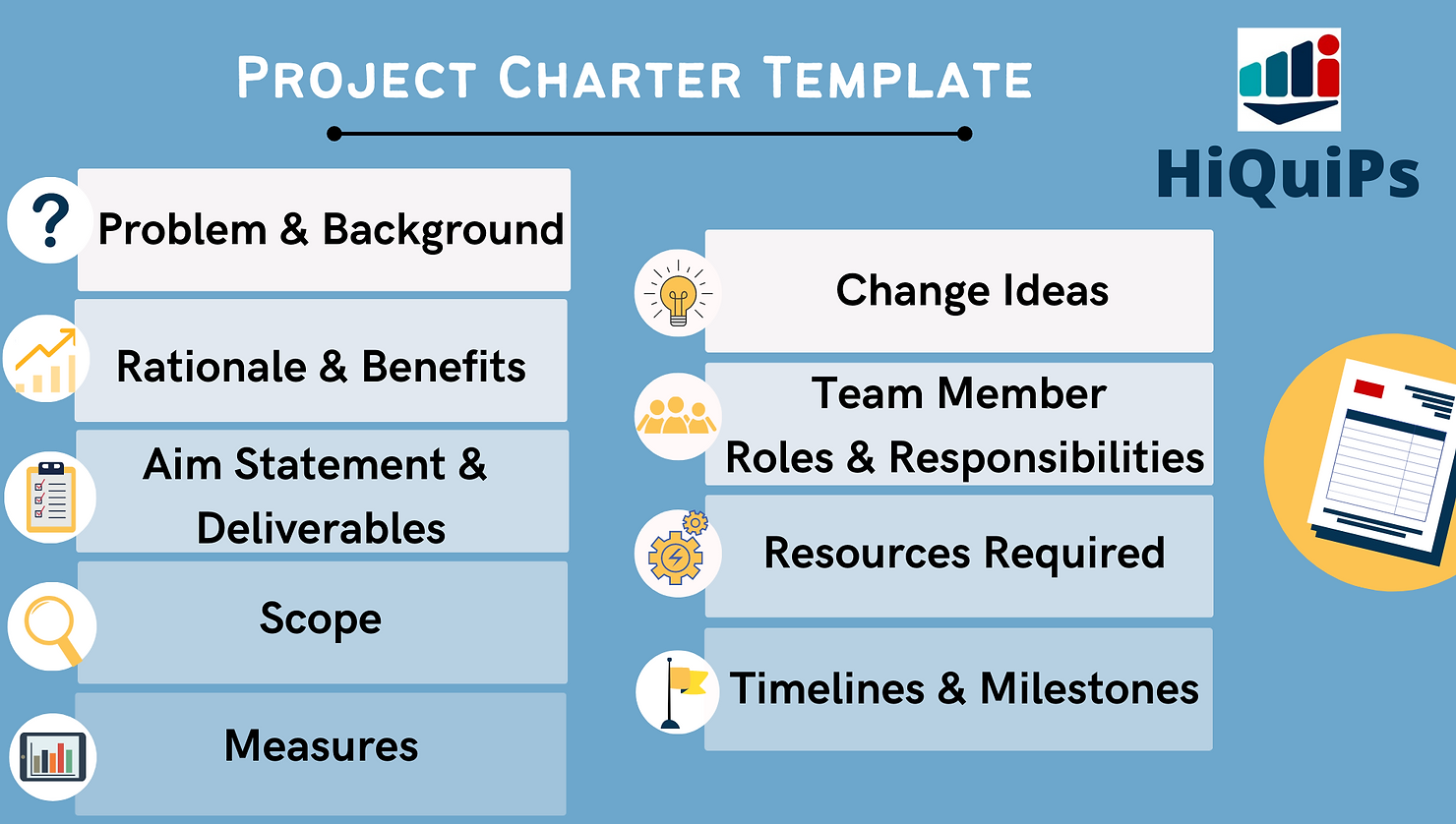You’ve completed a Quality Improvement (QI) project and you’re thinking about how you might align your efforts with those of your colleagues to build a community of practice that can prioritize, support, and deliver a comprehensive program of high-quality Q&S work. But where to start? What are the crucial steps and antecedents for success in building a robust Quality & Safety (Q&S) infrastructure?
Welcome to this HiQuiPs post that offers a roadmap on how to build a Q&S committee in your department or program.

Phase 1 – Assemble Leadership Team & Define Vision
Your first step on this journey is to identify a Co-Chair dyad with complementary perspectives, for example, a nursing or allied health professional and a physician. This dyad model is essential for the coordination of efforts across disciplines, ensuring the amalgamation of diverse experiences, and enabling the greatest chance for the interprofessional buy-in needed for success. Develop Formal Terms of Reference (see template here) to lend credibility to your efforts, including a compelling vision and mission statement to eventually be refined and validated by your constituency. Early discussions with your local leadership team should center on the establishment of priorities for your Q&S committee that leverage the expertise of your expected membership and are informed by your organization’s strategic vision, priorities, and local quality gaps. Once the committee’s leadership has been established, your Terms of Reference have been drafted, and your priorities have been defined, discuss with the departmental leadership to secure engagement and propose appropriate resourcing (e.g. administrative support for meeting scheduling and coordination, which may be shared with operational or academic supports).
Phase 2 – Recruit & Engage Members
Once you’ve secured departmental leadership to support your efforts, the next step is to actively expand your community of practice and build your committee. Make efforts to seek out members who are interprofessional, driven, diverse, respected, and knowledgeable. Ask leadership to identify potential members through social capital via already established connections and departmental all-user email invitations. Try to think outside the box – you might include groups of nursing students wanting to organize their improvement efforts for curriculum development, or medical residents wanting to change the way they contribute to care across the system. Once you’ve established a core group, work together to continue to formalize strategic priorities through the identification and refinement of issues that resonate with the team. Through data and stories, demonstrate how the benefits of future improvements will outweigh the cost of required efforts. Work together to collaboratively define meeting structure, frequency, and content (see Meeting Agenda template here). Monthly to quarterly meetings are advisable to encourage momentum. Advocate for resources from departmental leadership to facilitate ongoing success. Additionally, establish an agreement that small sums of operational funding will be available for ad hoc project needs, and in-kind support for committee members to have time protected for meetings and projects.
Phase 3 – Accelerate Growth
Continue to advance the development of committee members’ expertise in Q&S skills and topics to ensure sustained efforts and accelerate growth. Conduct a simple needs assessment to obtain a baseline understanding of your group’s Q&S needs and wants. Professional development through training programs should be encouraged and resourced where possible, such as the HiQuiPs Incubator Program, the Institute for Healthcare Improvement’s Basic Certificate Course, or the University of Toronto’s Centre for Quality Improvement and Patient Safety (CQuIPS) Certificate or Masters Program (for additional options, visit the Canadian Association of Emergency Physicians (CAEP) Quality Improvement and Patient Safety (QIPS) Resource Centre). Members should also be encouraged to build external Q&S connections by joining established Q&S communities of practice such as CQuIPS’ QIPS Community of Practice. Consider reaching out to your organization’s Q&S office to determine if local Q&S sessions (e.g., rounds or workshops) are offered at your center. Make concerted efforts to keep members engaged, encouraged, and motivated through mentorship and individualized support. Be keen to develop an understanding of your constituency’s assets and orchestrate connections strategically based on strengths and needs. If one member of your group is strong in project design and another in advanced analytics, be intentional about bringing them together to form a dynamic and complementary team. Aim to support projects with higher impact but lower effort (i.e. lower-hanging fruits), and encourage the use of Project Charters to keep work in scope (see Project Charter Template here).

Phase 4 – Sustain Impact
To ensure sustained impact, aim to individually and collectively recognize members and projects at huddles, meetings, and in organization-wide messaging. Wins should be celebrated early and often! Organize QI awards and presentation days to celebrate these wins publicly, and build momentum and camaraderie. Share key findings that have improved patient care across your organization, specifically emphasizing those that have reduced provider frustrations. Support the scholarly dissemination of work, and seek out internal and external grant funding where possible to boost morale and credibility. The broad distribution of a 1-page key messages document following each meeting can also help raise the bar for the legitimacy of your committee’s endeavours. Incentivize members where possible with financial support, effort recognition, and career advancement opportunities. Finally, always be on the lookout for disengagement and burnout, and build wellness checks into your regular meeting structure.
With these sequential steps and tips for success now in your repertoire, you’re all set to embark on your journey toward building Q&S infrastructure. As you start on your way, be kind to yourself and your team – the road will be long and obstacles will surely present themselves. Pacing yourself, taking any wins as they come, and keeping the end game in mind will help you and your team stay resilient and motivated. Good luck!
This post was copyedited by Mackenzie MacAuley
Senior Editor Ahmed Taher



